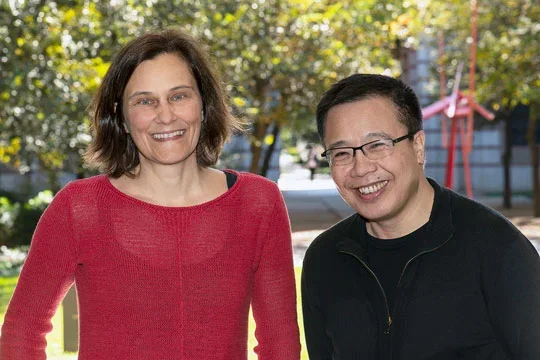Reviewed by Danielle Ellis, B.Sc.Sep 9 2024
A recent study conducted by Rice University’s Qimiao Si has discovered a new type of quantum critical metal, providing insight into electron interactions inside quantum materials. The study, published in Physical Review Letters on September 6th, 2024, investigates the effects of Kondo coupling and chiral spin liquids in certain lattice structures.
 Physicists Silke Paschen (left) of Vienna University of Technology and Qimiao Si of Rice University at Rice in November 2021. Image Credit: Tommy LaVergne/Rice University.
Physicists Silke Paschen (left) of Vienna University of Technology and Qimiao Si of Rice University at Rice in November 2021. Image Credit: Tommy LaVergne/Rice University.
The insights gained from this discovery could lead to the development of electronic devices with extreme sensitivity, driven by the unique properties of quantum-critical systems.
Qimiao Si, the Harry C. and Olga K. Wiess, Professor, Department of Physics and Astronomy, Rice University
Si is also the director of Rice’s Extreme Quantum Materials Alliance.
Quantum Phase Transitions
The idea of quantum phase transitions is at the heart of this study. Electrons in quantum materials can transition between multiple phases in response to changes in their environment, much as water can vary between solid, liquid, and gaseous forms. However, these electrons behave far more complexly because they adhere to the laws of quantum physics, unlike water.
Quantum mechanics introduces two important phenomena: electronic topology and quantum fluctuations. Quantum fluctuations can change the way electrons are arranged, resulting in quantum phase transitions, even at zero temperature, when thermal fluctuations vanish. These transitions frequently produce quantum criticality, a term for extreme physical qualities.
Furthermore, topology—a mathematical idea—gives electrons a special quality that, when applied to electronic states, can result in odd and perhaps beneficial behaviors. This attribute of electrons is a result of quantum mechanics.
Si's group worked closely with Silke Paschen, a physics professor at the Vienna University of Technology and co-author of the study, and her research team to complete the study. They collaborated to create a theoretical framework to investigate these quantum phenomena.
The Theoretical Model
The scientists looked at two distinct types of electrons: those that moved swiftly in a fast lane and those that moved slowly, like cars trapped in traffic. The spins of the slowly moving electrons can point in any direction, even if they appear to be immobile.
Si added, “Ordinarily, these spins would form an orderly pattern, but the lattice they inhabit in our model doesn’t allow for such neatness, leading to geometrical frustration.”
Instead, the spins create a more fluid arrangement called a quantum spin liquid, which is chiral and chooses a direction in time. When this spin liquid interacts with fast-moving electrons, it produces a topological effect.
The researchers observed that this coupling also causes a shift into a Kondo phase, in which the slow electrons' spins latch onto the rapid ones. The study demonstrates the intricate relationship between electronic topology and quantum phase transitions.
Usual Electrical Transport
As electrons pass through these transitions, their behavior changes considerably, notably in terms of electrical conductivity.
According to Paschen, one of the most significant results is regarding the Hall effect, which describes how an electrical current bends in response to an external magnetic field.
The Hall effect contains a component that is enabled by the electronic topology. We show that this effect experiences a sudden jump across the quantum critical point.
Silke Paschen, Study Co-Author and Professor, Physics, Vienna University of Technology
Implications for Future Technology
This breakthrough increases the understanding of quantum materials and creates new opportunities for future technologies. According to Si, one noteworthy aspect of the study team’s discovery is that the Hall effect responds significantly to the quantum phase shift.
“Thanks to the topology, this response happens in a minute magnetic field,” stated Si.
These peculiar qualities could encourage the creation of novel electronic devices, such as extremely sensitive sensors, which have the potential to transform industries such as environmental monitoring and medical diagnostics.
Wenxin Ding of Anhui University in China, a former postdoctoral fellow in Si’s group at Rice, and Rice alumna Sarah Grefe ’17 of California State University are the other study co-authors.
The study was supported by the US National Science Foundation, the Air Force Office of Scientific Research, the Robert A. Welch Foundation, and a Vannevar Bush Faculty Fellowship.
Journal Reference:
Ding, W., et al. (2024) Anomalous Hall Effect and Quantum Criticality in Geometrically Frustrated Heavy Fermion Metals. Physical Review Letters. doi.org/10.1103/PhysRevLett.133.106504